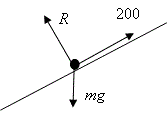Solutions
| 1 (a)
| \displaystyle \begin{align}
& 44\textrm{.}1=\frac{1}{2}\times 9\textrm{.}8{{t}^{2}} \\
& t=\sqrt{\frac{44\textrm{.}1}{4\textrm{.}9}}=3\text{ s} \\
& \\
& \text{OR} \\
& \\
& s=\frac{1}{2}\times 9\textrm{.}8\times {{3}^{2}}=44\textrm{.}1 \\
& \therefore \text{Hits ground after 3 seconds} \\
\end{align}
AG
| M1
A1
A1
(M1)
(A1)
(A1)
| (3 marks)
| M1: Use of constant acceleration
equation with \displaystyle v=0
A1: Correct equation
A1: Correct \displaystyle s
|
| 1 (b)
| \displaystyle \begin{align}
& {{v}^{2}}={{0}^{2}}+2\times 9\textrm{.}8\times 44\textrm{.}1 \\
& v=\sqrt{864\textrm{.}36}=29\textrm{.}4m \\
& \\
& \text{OR} \\
& \\
& v=0+9\textrm{.}8\times 3 \\
& v=29\textrm{.}4 \\
\end{align}
| M1
A1
A1
| (3 marks)
| M1: Use of constant acceleration equation with \displaystyle v=0
A1: Correct equation.
A1: Correct \displaystyle v.
|
| 1 (c)
| Air resistance would slow the ball down.
| B1
| (1 mark)
| B1: Sensible statement about air resistance.
|
|
|
|
| (7 marks)
|
|
| 2 (a)
| 
| B1
| (1 mark)
| B1: Correct horizontal forces.
Ignore any vertical forces.
|
| 2 (b)
| \displaystyle P = 900 \text{N}
| B1
| (1 mark)
| B1: Correct value for \displaystyle P.
|
| 2 (c)
| \displaystyle \begin{align}
& P-900=2000\times 1\textrm{.}2 \\
& P=2400+900=3300 \text{N} \\
\end{align}
| M1
A1
A1
| (1 mark)
| M1: Three term equation of motion
A1: Correct equation
A1: Correct \displaystyle P.
|
| 2 (d)
| \displaystyle \begin{align}
& 800-900=2000a \\
& a=\frac{-100}{2000}=-0\textrm{.}05 \text{ m}{{\text{s}}^{-2}} \\
& \text{Car is slowing down} \\
\end{align}
| M1
A1
A1
A1
| (4 marks)
| M1: Three term equation of motion
A1: Correct equation
A1: Correct \displaystyle a
A1: Correct statement
|
|
|
|
| (9 marks)
|
|
| 3 (a)
| \displaystyle R=20\times 9\textrm{.}8=196 N
| M1
A1
| (2 marks)
| M1: Use of \displaystyle R=mg
A1: Correct \displaystyle R.
|
| 3 (b)
| \displaystyle F=0\textrm{.}4\times 196=78\textrm{.}4 N
| M1
A1
| (2 Marks)
| M1: Use of \displaystyle F=\mu R
A1: Correct \displaystyle F.
|
| 3 (c)
| \displaystyle \begin{align}
& 100-78 \textrm{.}4=20a \\
& a=\frac{100-78 \textrm{.}4}{20}=1 \textrm{.}08 \text{ m}{{\text{s}}^{-2}} \\
\end{align}
| M1
A1
A1
| (3 marks)
| M1: Three term equation of motion
A1: Correct equation
A1: Correct \displaystyle a.
|
|
|
|
| (8 marks)
|
|
| 4 (a)
| 
| B1
| (1 mark)
| B1: Correct force diagram
|
| 4 (b)
| \displaystyle \begin{align}
& 100a=200-980\sin 5{}^\circ \\
& a=\frac{200-980\sin 5{}^\circ }{100}=1\textrm{.}15\ \text{m}{{\text{s}}^{-2}} \\
\end{align}
| M1A1
M1
A1
| (4 marks)
| M1: Three term equation of motion
A1: Correct equation
M1: Rearranging equation.
A1: Correct \displaystyle a.
|
| 4 (c)
|
\displaystyle \begin{align}
& s=0\times 5+\frac{1}{2}\times 1\textrm{.}15\times {{5}^{2}} \\
& =14\textrm{.}4\ \text{m} \\
\end{align}
| M1
A1
A1
| (3 marks)
| M1: Using a constant acceleration equation
A1: Correct equation
A1: Correct distance.
|
|
|
|
| (8 marks)
|
|
| 5 (a)
| \displaystyle \mathbf{v}=(6\mathbf{i}+4\mathbf{j})+(0\textrm{.}2\mathbf{i}-0\textrm{.}4\mathbf{j})t
| M1
A1
| (2 marks)
| M1: Use of \displaystyle \mathbf{v}=\mathbf{u}+\mathbf{a}t
A1: Correct expression
|
| 5 (b)
| \displaystyle \begin{align}
& 4-0\textrm{.}4t=0 \\
& t=10 \ \text{s}\\
\end{align}
| M1
A1
A1
| (3 marks)
| M1: Using \displaystyle \mathbf{j} component equal to zero.
A1: Correct equation.
A1: Correct time.
|
| 5 (c)
| \displaystyle \begin{align}
& \mathbf{r}=(6\mathbf{i}+4\mathbf{j})\times 30+\frac{1}{2}(0\textrm{.}2\mathbf{i}-0\textrm{.}4\mathbf{j})\times {{30}^{2}} \\
& =270\mathbf{i}-60\mathbf{j} \\
& r=\sqrt{{{270}^{2}}+{{60}^{2}}}=277\ \text{m} \\
\end{align}
| M1
A1
M1
A1
| (4 marks)
| M1: Using \displaystyle \mathbf{r}=\mathbf{u}t+\frac{1}{2}\mathbf{a}{{t}^{2}}
A1: Correct position vector.
M1: Finding distance.
A1: Correct distance
|
|
|
|
| (8 marks)
|
AG: Answer Given in Question – Working must justify answer.